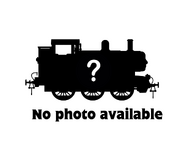The Sodor and Mainland Railway (S&M) was the first standard gauge railway built on the Island of Sodor. Despite its name, it never reached the Mainland and was a financial disaster. It was absorbed into the North Western Railway in 1914.
History
The Railway Series
The Sodor & Mainland was first promoted in 1850 and was projected to link Barrow-in-Furness with Suddery, the ancient capital of Sodor. There was plenty of local enthusiasm, but little intrest in the service on the Mainland.[1] The railway canvassed support from local investors, promising those from Peel Godred that they'd build a branch line north from Cronk to the town. The railway received its Act of Parliament in 1853, which included powers to build the proposed Peel Godred branch[2], allowing construction to proceed, with a single line track being laid between Ballahoo and Rolf's Castle.
Many of the S&M's staff originally came from Ireland or Scotland. The railway had three locomotives, which were typical contractors' engines of the period. The S&M was a company whose attitude to records could be described as casual, and many details about these locomotives, such as their acquisition, have been lost.[3] In 1865, the S&M extended from Rolf's Castle to the fishing port of Kirk Ronan. They hoped to start a steamer service from Kirk Ronan to Dublin. This project failed, but the Skarloey Railway started operating in May the same year. The two railway's connected at Crovan's Gate, and the S&M was responsible for delivering its two original locomotives. The Crovan's Gate Mining Company used Kirk Ronan extensively for the shipment of ore, which would be delivered to the harbour by the S&M.[4]
The railway, ultimately, proved to be ambitious, but ill-fated and the Company's high hopes were disappointed. Their tunnel through the Ballahoo Ridge collapsed, preventing the railway from connecting with Vicarstown, and their attempts to erect a bridge across the Walney Channel faired no better.[5] The Admiralty was obstructive about the proposed low-level bridge across the straits from the start. When permission was finally obtained, attempts at construction was dogged with difficulties. First, foundations were washed away by the tide, then part of one of the spans was lost when cranes broke while hoisting it into position, and eventually the almost completed bridge was wrecked by a gale. Following the Tay Bridge disaster of 1879, further bridge-building attempts were indefinitely shelved, and all subsequent proposals were baulked by the Admiralty.[6]
Due to these severe setbacks, trains only ended up running between Kirk Ronan and Ballahoo, and by 1870 the company was already teetering on the verge bankruptcy. By this point, the people of Peel Godred had realised that their promised branch line would never be built by the S&M, and came to conclusion that they must build it themselves. They initially favoured a line built on the route proposed by the S&M, but as it would have involved a junction somewhere with the S&M, most felt that to embark on such a project would be the height of imprudence. They opted to look elsewhere, which led to the formation of the Mid Sodor Railway in 1872.[7]
Bankruptcy finally came in 1901, and the last of its locomotion were scrapped that year, bringing services to an end, but the company remained in being, simply dormant. In 1914, the railway was merged with the Wellsworth and Suddery Railway and the Tidmouth, Knapford and Elsbridge Light Railway to form the North Western Railway in a Government sponsored amalgamation of the standard gauge railways in the Island to create a strategic railway for coastal defence against possible danger from Ireland.[8] The S&M line between Kellsthorpe and Crovan's Gate became part of the Main Line, while the section between Kirk Ronan and Kellsthorpe became the Kirk Ronan Branch Line, and the section between Crovan's Gate and Ballahoo became part of the Norramby Branch Line.
The North Western Railway ended up completing many of the goals of the Sodor & Mainland. In 1915, it cut a tunnel through the Ballahoo Ridge to Vicarstown and erected a bridge across the Channel (ironically, the Admiralty, which had caused the S&M much strife during its bridge building efforts, was the main backer of the formation of the NWR), finally connecting Sodor and the Mainland[9]. In 1920, it launched a successful steamer service from Kirk Ronan, though was forced to curtail the service as part of a deal with the LMS in 1925, and in 1923, using powers it had inherited from the S&M, constructed the long awaited branch line to Peel Godred.
Rolling Stock
Locomotives
References
| Locomotives | S&M #1 | Neil | S&M #3 |
|---|---|
| Rolling Stock | Coaches | Trucks | Flatbeds, Conflats and Well Wagons |
| Locations | Kirk Ronan (Harbour) | Rolf's Castle | Crovan's Gate | Ballahoo |

